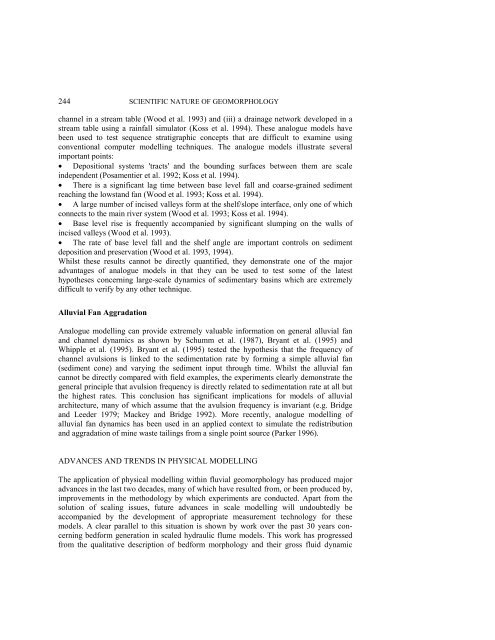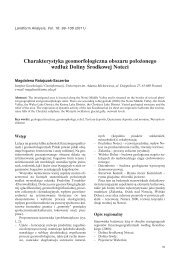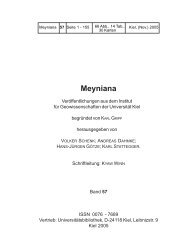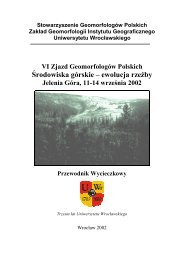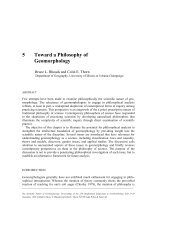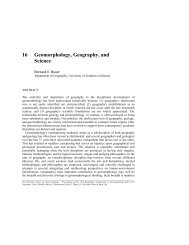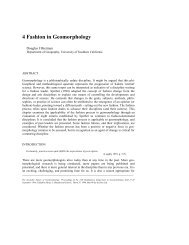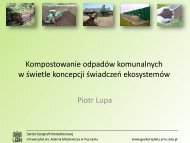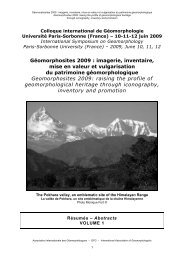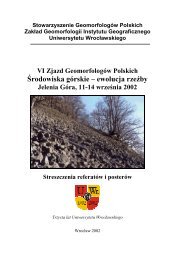Physical Modelling in Fluvial Geomorphology
Physical Modelling in Fluvial Geomorphology
Physical Modelling in Fluvial Geomorphology
Create successful ePaper yourself
Turn your PDF publications into a flip-book with our unique Google optimized e-Paper software.
244 SCIENTIFIC NATURE OF GEOMORPHOLOGY<br />
channel <strong>in</strong> a stream table (Wood et al. 1993) and (iii) a dra<strong>in</strong>age network developed <strong>in</strong> a<br />
stream table us<strong>in</strong>g a ra<strong>in</strong>fall simulator (Koss et al. 1994). These analogue models have<br />
been used to test sequence stratigraphic concepts that are difficult to exam<strong>in</strong>e us<strong>in</strong>g<br />
conventional computer modell<strong>in</strong>g techniques. The analogue models illustrate several<br />
important po<strong>in</strong>ts:<br />
• Depositional systems 'tracts' and the bound<strong>in</strong>g surfaces between them are scale<br />
<strong>in</strong>dependent (Posamentier et al. 1992; Koss et al. 1994).<br />
• There is a significant lag time between base level fall and coarse-gra<strong>in</strong>ed sediment<br />
reach<strong>in</strong>g the lowstand fan (Wood et al. 1993; Koss et al. 1994).<br />
• A large number of <strong>in</strong>cised valleys form at the shelf/slope <strong>in</strong>terface, only one of which<br />
connects to the ma<strong>in</strong> river system (Wood et al. 1993; Koss et al. 1994).<br />
• Base level rise is frequently accompanied by significant slump<strong>in</strong>g on the walls of<br />
<strong>in</strong>cised valleys (Wood et al. 1993).<br />
• The rate of base level fall and the shelf angle are important controls on sediment<br />
deposition and preservation (Wood et al. 1993, 1994).<br />
Whilst these results cannot be directly quantified, they demonstrate one of the major<br />
advantages of analogue models <strong>in</strong> that they can be used to test some of the latest<br />
hypotheses concern<strong>in</strong>g large-scale dynamics of sedimentary bas<strong>in</strong>s which are extremely<br />
difficult to verify by any other technique.<br />
Alluvial Fan Aggradation<br />
Analogue modell<strong>in</strong>g can provide extremely valuable <strong>in</strong>formation on general alluvial fan<br />
and channel dynamics as shown by Schumm et al. (1987), Bryant et al. (1995) and<br />
Whipple et al. (1995). Bryant et al. (1995) tested the hypothesis that the frequency of<br />
channel avulsions is l<strong>in</strong>ked to the sedimentation rate by form<strong>in</strong>g a simple alluvial fan<br />
(sediment cone) and vary<strong>in</strong>g the sediment <strong>in</strong>put through time. Whilst the alluvial fan<br />
cannot be directly compared with field examples, the experiments clearly demonstrate the<br />
general pr<strong>in</strong>ciple that avulsion frequency is directly related to sedimentation rate at all but<br />
the highest rates. This conclusion has significant implications for models of alluvial<br />
architecture, many of which assume that the avulsion frequency is <strong>in</strong>variant (e.g. Bridge<br />
and Leeder 1979; Mackey and Bridge 1992). More recently, analogue modell<strong>in</strong>g of<br />
alluvial fan dynamics has been used <strong>in</strong> an applied context to simulate the redistribution<br />
and aggradation of m<strong>in</strong>e waste tail<strong>in</strong>gs from a s<strong>in</strong>gle po<strong>in</strong>t source (Parker 1996).<br />
ADVANCES AND TRENDS IN PHYSICAL MODELLING<br />
The application of physical modell<strong>in</strong>g with<strong>in</strong> fluvial geomorphology has produced major<br />
advances <strong>in</strong> the last two decades, many of which have resulted from, or been produced by,<br />
improvements <strong>in</strong> the methodology by which experiments are conducted. Apart from the<br />
solution of scal<strong>in</strong>g issues, future advances <strong>in</strong> scale modell<strong>in</strong>g will undoubtedly be<br />
accompanied by the development of appropriate measurement technology for these<br />
models. A clear parallel to this situation is shown by work over the past 30 years concern<strong>in</strong>g<br />
bedform generation <strong>in</strong> scaled hydraulic flume models. This work has progressed<br />
from the qualitative description of bedform morphology and their gross fluid dynamic


